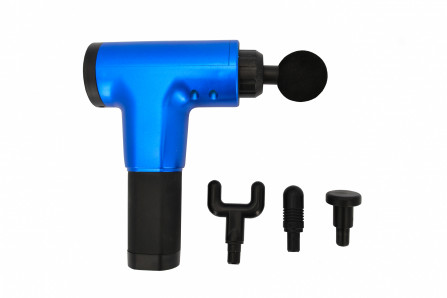How to treat trigger points at home
Trigger points can be a painful and sometimes debilitating condition that often require courses of therapy that can be painful, invasive... Read Article

Muscles knots can make you feel stiff and tired, plus cause a host of muscular aches and pains. Professional therapies and painful self treatments can give relief, but the pain usually comes back.
To help help you avoid the pain and expense, in this guide we will share with you what they are and what causes them, how to prevent them, and if you do have them how are they best treated.
What muscle knots are
What cause muscles knots,
How to prevent muscle knots
How they are best treated
Specific treatment for various muscles and various conditions
Of course there is no actual knot in the muscle. The lumps are actually a part of your muscle that has spasmed or tightened, bunching up. This will cause:
The technical name
We will use the term “muscle knots” in this guide, but the technical name is (myofascial) trigger points, or trigger points for short. The scientific articles we mention will use this term.
We have seen guides advising that muscle knots are parts of muscles with scar tissue, adhesions and inflammation. While muscles can have these this is not what forms the lumps you feel. The people giving this advise do not understand what they are treating, so give totally inappropriate advice.
As mentioned muscle knots can cause stiffness, tiredness plus a host of muscular aches and pains. One reason for such a wide range of symptoms is that muscle knots can shoot pain well away from the actual lump. Scientists have mapped much of this, as shown in the following diagrams.
Muscle knots do not show up in any medical scans or laboratory tests (so medical doctors usually don’t find or diagnose them). They can only be found and diagnosed by a properly trained professional physically examining the muscles, looking for the tightness, lump, tenderness and shooting pain.
You may read lists of things that cause muscle knots, However, the two main underlying causes are:
This can be either repeated stress or constant tension
This occurs when muscles are repeatedly worked without having time to recover. An example would be repeatedly doing the same task, such as a trades person might do or even repeatedly using a keyboard.
This is where muscles are under continued stress without being able to relax and recover. As we will see in the next section when a muscle is under tension it also presses on blood vessels restricting blood flow.

As discussed above when muscles are constantly tight they press on blood vessels restricting blood flow. Also your veins and lymphatic system (the waste system of your body) rely on alternating tightening and relaxing of you muscles to pump. Because of this when your muscles are constantly tight they do not get sufficient nutrients and suffer a build up of waste products. This is the perfect environment for forming muscle knots. Below are three common examples where this happens.

Sitting at a desk can often cause your muscles to be tight for long periods of time. Because of this office workers often develop muscle knots in their neck and shoulder muscles.
Emotional stress and tension can cause muscles around the head and neck to tighten. The muscle knots these cause are a major cause of headaches.
As discussed above muscle knots themselves cause muscles to tighten and restrict blood flow. Therefore, once you have muscle knots they create the perfect environment to keep growing and for more to develop. This is why once you have them they almost never go away on their own, and why they keep coming back after being treated. Later in this article we will show you how to overcome this to successfully get rid of them.
There are a number of things you can do to help prevent muscle knots. These all involve minimising or eliminating the two main underlying causes. Let’s look at some examples.
As we have seen existing muscle knots cause muscles to tighten and restrict blood flow, which cause more muscle knots to develop and the existing ones to worsen. Later in this article we will show you the best way to treat them.
Emotional tension and stress and be a significant cause of muscle knots, especially in the head and neck muscles. As an example, during the exam period in Chiropractic College fellow students sought regular treatments. This is not our area of expertise, so if this is a concern we advise that you seek appropriate advice.
Issues with your spine and posture are a very common cause of muscles to be abnormally tight. For more information about this and what to do please see this article
Causes of muscle knots can easily be minimised, but it is practically impossible top eliminate them altogether. Therefore it is great to do some ongoing muscle care to keep them from tightening and to keep an excellent blood flow. To do this we recommend:
If you have had treatment for muscle knots before you will understand that there are a wide range of potential treatments, but which ever treatment you use the muscle knots always seem to come back. In this guide we will explain why the pain keeps coming back and what you can do about it.
Muscle knots are long term changes to your muscles. They start small and gradually grow, but do not start causing pain until they are much larger. Typical courses of therapy such as needles, laser or manual techniques just quieten down the muscle knots enough so they stop hurting, but do not reverse the long term changes.

Although advocates of therapies such as needles and lasers like to refer to clinical trials showing their therapy is “scientifically proven” all those trials prove is that they can relieve pain. They all very conveniently forget to check whether the muscle knots were still there. As this chart shows, in one of the very few trials where they actually did most of the muscle knots “trigger points” were still there after 12 weeks of very extensive treatment.
Note: For a thorough guide will full instructions please see our Trigger point therapy guide . However, we give a summary here.
To rid muscle knots permanently we need to acknowledge that our treatment and management need to address long term changes rather than just the pain. There are two parts to this strategy:
In the example above while most of the muscle knots were still there some were gone and the rest had diminished in size. This means that you need to continue treatments for long after the pain goes away. For most using professionals to do this would inconvenient and prohibitively expensive, but this is easily achievable using an easy, effective self-treatment. For self treatment we have two options:
1. Pressure techniques
2. Vibration massage (recommended)
Pressure techniques have been used by professional therapists, and there are a large number of websites and videos advising this treatment. Technically it does work, but is hard to do, not that effective and hurts so much people rarely persist long enough to get lasting benefits.

This is by far the easiest, safest and most effective of the home techniques, but you need a proper vibration massager. We’ve got a separate vibration massage usage guide that gives full details, but simply speaking all you need to do is sit the head of the massager over the trigger point and let the vibrations penetrate.
This pic is of a professional model, but a properly designed personal use vibration massagers have ergonomically designed handles to allow you reach and apply this therapy anywhere on your body. However, as discussed in our guide Why most massagers are a waste of money , most of the vibrating massagers you can buy are not suitable.
In this section:

Looking back at how trigger points form we see that it involves spasm, reduced blood flow and a build up of toxic wastes basically going around in circles feeding on each other. Scientists have found that vibrations help each of these issues, so the vibrations from the massager will gradually “dissolve” the trigger points.

Most vibrating massagers built for consumer use are built to look good on shop shelves rather than be serious therapeutic devices. These usually have low powered motors and inadequate mechanisms, so are not capable of delivering adequate vibration.

Rather than having a pad that sits on the surface and sending in vibrations massage guns (percussion massagers) are designed to drive their heads in like jackhammers. Because of this they:
When we were looking for a suitable vibration massager for our patients to use all the effective machines seemed to be "professional" products for therapists to use. These were expensive and not designed for self use. Because of this we built our own that pack the effectiveness of a professional unit into an economical one for self use. They are now used, recommended and sold by over a thousand clinics across half the world (some examples). For information about these and where to get them please use these links.
The General Purpose Massager
The Ultimate Quad Head Massager
Read what professionals say about DrGraeme massagers
While your muscle knots are being treated it is important to avoid the things discussed above cause muscle knots to develop.
In this section we will link to resources to help you with muscle knots for various conditions. These will use the technical term “trigger points’, but you know its the same thing.
Shoulder pain
Fibromyalgia
Headaches and migraines
Tennis elbow
Back pain
Calf pain

Most of our massager sell through colleagues using our machines and recommending the therapy to patients/clients, so we are very happy to send appropriately qualiied professionals a complimentary sample machines to trial. For more info please see our Professional sample sample page .
We are continually adding more information on research and uses. Subscribe below to have us email them to you "hot off the press".

Several years ago Dr Graeme, a Chiropractor practicing in Victoria, Australia was looking for a serious hand held massager his patients could use at home to get the extra quality massage they needed. The ones he found in the shops and on-line for home use looked nice but were not serious, and... read more
Trigger points can be a painful and sometimes debilitating condition that often require courses of therapy that can be painful, invasive... Read Article
Muscles knots can make you feel stiff and tired, plus cause a host of muscular aches and pains. However, a lot of advice and treatments... Read Article
As a chiropractor for over 27 years vertebral subluxation complexes are a very real problem that can cause pain, long term spinal damage... Read Article
The main reasons trigger points keep coming back is because courses of trigger point therapy are only designed to temporarily relieve... Read Article
If you’ve got a headache it would be nice if you do some massage or press pressure points rather than rely on drugs or other therapies. ... Read Article
Sports massages are widely used with both professional (paid) and self help options. If you are looking at sports massages the main... Read Article
Do not refresh or leave this page until loading complete.